Exercising during pregnancy can have plenty of benefits. Not only will it keep you in shape, help it also helps with labor. However, it must be done the right way or you’ll get injured. Or worse, you could injure your baby.
Benefits
In April 2020 the American College of Obstetricians and Gynecologists (ACOG) released an article about exercise during pregnancy.
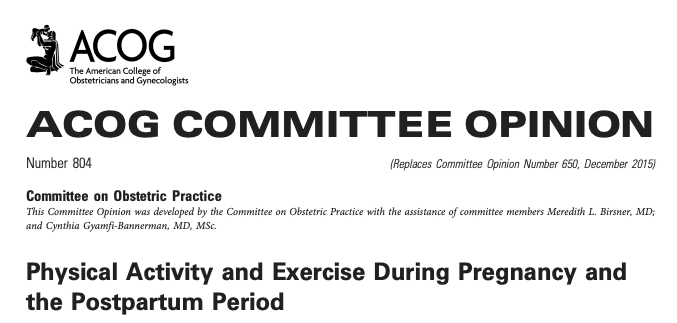
According to their study, physical activity is beneficial for most pregnant women. However, certain exercises and routines must be adapted to the new requirements. A clinical examination must be performed before engaging in an exercise program to make sure there are no medical reasons to avoid exercise during pregnancy. There shouldn’t be activity restriction routinely except to those women with certain pathological conditions.
How much should you exercise during pregnancy?
First, you should visit your doctor at the beginning of your pregnancy. In their article, ACOG recommends 150 minutes of physical activity every week. That would be 30 minutes daily for 5 days for example, and then 2 days resting.
Benefits
There are some proven benefits of exercise in pregnancy, like higher incidence of vaginal delivery. Also, there are lower rates of gestational diabetes and hypertension, as well as less preterm births.
Risks
It’s better to avoid activities with violent moves and those with the risk of falling or injuring yourself. So, now is not the time to start boxing, skydiving, or snowboarding because any injure can harm your baby.
Also, there are also some conditions that can increase the risk for your baby such as placenta previa, incompetent cervix, ruptured membranes… During your pregnancy, your doctor will run some tests every trimester, including ultrasounds. That way they will check if you suffer any of these conditions. If you do, your doctor will tell you what to do and which exercises are okay with your specific condition. Don’t push too far if you have any of these conditions: you could trigger preterm labor or placental bleeding.
Tips
Take it easy. If you are starting now just start with some light routine, little by little. Even if you are a pro athlete, now is not the time to break your records. So take it down a notch. That means that you don’t have to go as far as exhaustion.
Avoid extreme temperatures. Avoid anything that will make your body suffer, because your baby will suffer too. Don’t exercise outside if it’s too cold or hot. Also, don’t use saunas.
Warm up and cool down. That’s something we should always do but more so during pregnancy. You want to prepare your body correctly so that everything runs smoothly.
Pay attention to your body. Your body is smart: if it hurts you should probably slow down or stop.
Watch your posture. Avoid lying on your back for long periods of time. When weeks go by and your belly grows, your womb and baby will compress everything around them. If you lie down on your back they will compress the structures right behind them: the aorta, inferior cava vein… You want to prevent that as it can lead to thrombosis and vascular complications.
Avoid aggressive moves. Don’t do full squats, jumping, jerk movements… as they are quite aggressive on the abdomen. They require sudden explosive movements that increase abdominal pressure. And you don’t want that.
Don’t get short on fuel. During pregnancy, you will need extra calories, hydrates, protein… After all, your baby is keeping some of it for himself. Remember to take some snacks with you so that you don’t get hypoglycaemic.
Cardio Exercise For Pregnancy
Do’s
Swimming. Also hydrotherapy, water aerobics… They all are good choices for exercise during pregnancy. Being in the water is good for your joints: your body is floating so your joints don’t have to carry your whole weight. During pregnancy, your body releases a hormone called relaxin, which makes your ligaments looser.

Walking. Walking is always a great option and you can fit it into your schedule any free moment you have. Remember to wear the right shoes or sneakers (high-heels are a no-no). If you feel comfortable walking, running is also ok. Just remember to not push it too far and listen to your body.
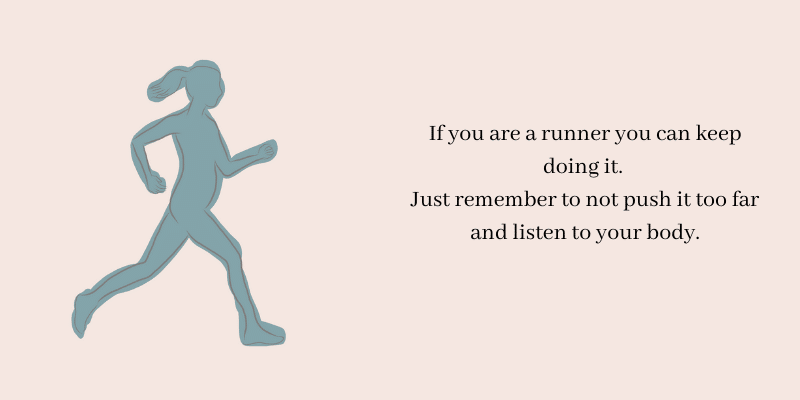
Indoor cycling. It’s a great activity as it allows you to get a good sweat while being pretty safe (no risk of falling or having an accident). It’s also quite harmless for your knees and ankles, there is little risk of spraining them. For the same reason, ellipticals and other similar activities are great options too.
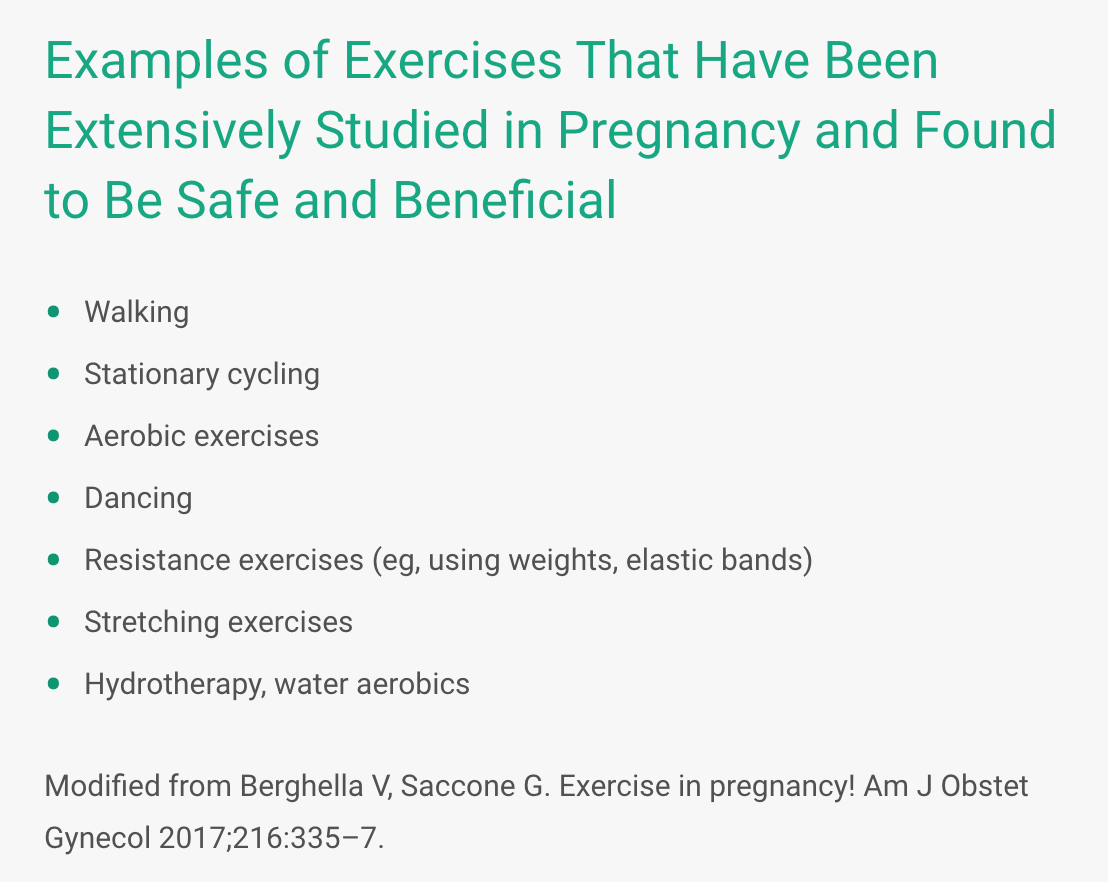
Don’ts
Boxing. Avoid all those contact sports where you will likely get injured or hit. If you are practicing fit-boxing and you let your trainer know you are pregnant, that might be ok. Just make sure you won’t get hurt. We would include other similar activities here like kickboxing, judo…
Ice-skating. Ice-skating, as well as snowboarding, skiing, horse riding… have a risk of falling and hurting yourself. During pregnancy it’s better to postpone all these activities. You’ll have time in the future to pick up your hobbies!
Strength Exercise For Pregnancy
There are several benefits to strength training during pregnancy. First, it can help protect your joints, making up for excessive laxity. Second, it will make it easier for you to bear the weight as your baby grows. Finally, a good overall muscular state can help with labor when the time comes.
Do’s
Weight lifting. Go for it but remember to use light weights. Instead, you can increase the number of repetitions. You must feel comfortable while doing it. That means you should feel your muscles getting sore but still be able to keep a perfect slow form.
Yoga, pilates… These exercises are great because they allow you to work your strength using only your body weight and different body positions. You will also work on your flexibility and help you feel calmer through breathing techniques.
Don’ts
Crossfit. As we explained before it is best to avoid those exercises that put too much pressure on your abdomen like jerk movements (push jerk, clean and jerk…). Your body won’t be at its best (we already talked about relaxin). And you are carrying another little person with you. For the same reason, try to avoid HIIT (high-intensity interval training) routines.

Exercises To Prepare For Labor
First, you have to be in overall good shape. That‘s important because it will allow you to push with intensity and not get exhausted. Labor can sometimes take time, especially if it is your first one. So it’s important that you can endure and keep pushing until it’s over. To be in good shape, you should do some of the routines we mentioned above, alternating between aerobic and strength exercises.
The second thing you can do is stretch and train your pelvic muscles. Your baby’s head will be about half his body size, and it has to go through your pelvis and pelvic floor. So it’s important to give those muscles as much flexibility as possible. These few exercises will help you with that:
· Child’s pose
Kneel down and sit on your heels. Then lean forward slowly and walk your arms out long in front of you. Breathe deeply. You also can rest your elbows on the ground in front of you with your hands supporting your head. As your belly grows, you may need to spread your knees farther apart to create space. If it’s uncomfortable to sit your backside on your heels, you can sit up higher.
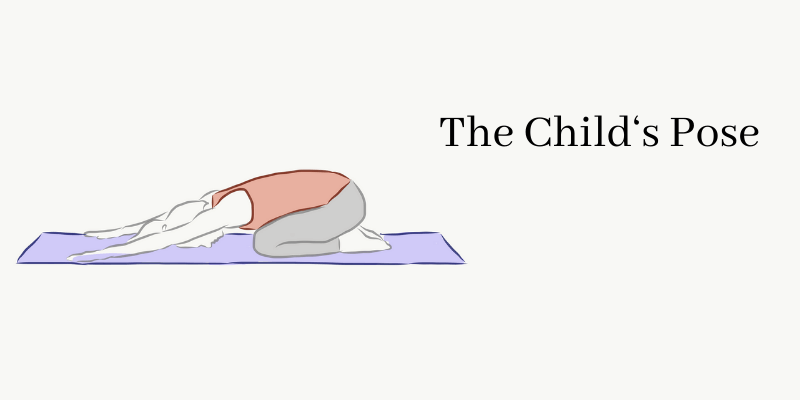
· Deep Squat
It’s like a regular squat but with no extra weight and maintaining the position when you flex. Stand with your legs wider than your hips. Then squat down as far as you can go with your hands pressed together in front of you. Keep the position for some seconds. That way you will relax and lengthen the pelvic floor muscles and stretch the perineum.
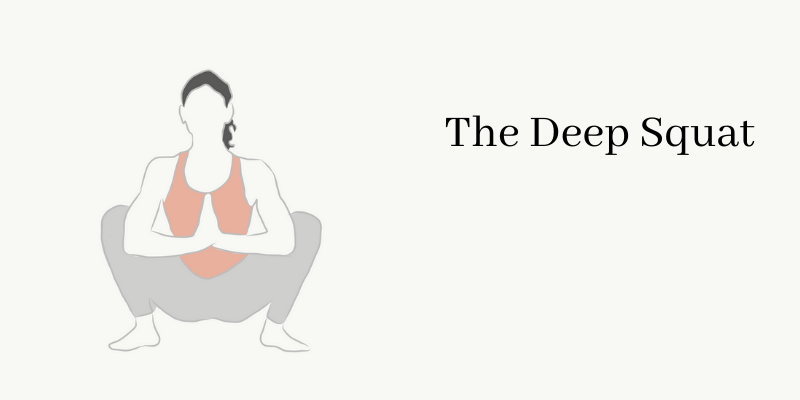
· Pelvic Tilts
Pelvic tilts are a subtle movement that strengthens the muscles from your lower back and abdominals. They help with low back pain and make labor easier too.
Lie on your back with bent knees and the soles of your feet on the floor. In this position, your lower back won’t be touching the floor due to the physiological curve or lordosis. That’s okay, you are doing it well. Then, as your exhale, gently rock your hips toward your head. This is a very subtle movement and you shouldn’t raise your buttocks from the floor (that would be a bridge exercise). Instead, when you do this you will notice that your lower back touches the floor. That is what the exercise is about. You rock your pelvis toward your head and your lower back flattens against the floor.
Don’t forget to keep breathing during the whole exercise. Maintain the position for 5 seconds and then relax. Do 5-10 reps.
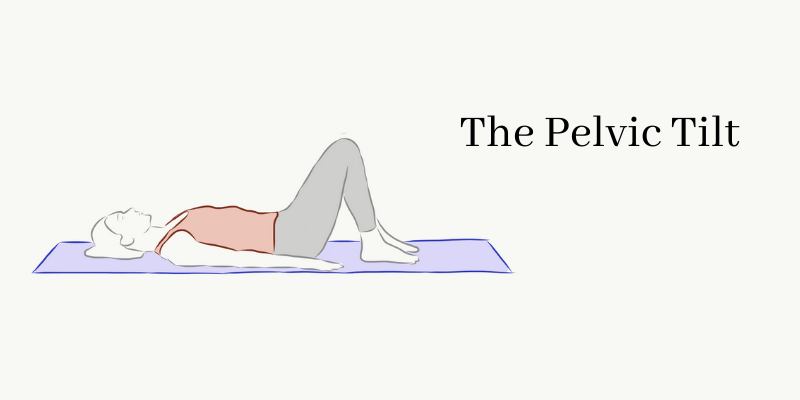
Working Out Pelvic Floor Muscles
After pregnancy and labor, your pelvic floor muscles will take some time to recover. Delivery is very traumatic for them, and you can undergo an episiotomy, where your doctor makes a cut through your vagina “to make it wider” so that the baby won’t tear your sphincters.
So, it’s quite frequent to suffer some degree of incontinence (you can’t hold 100% of the pee). With Kegel exercises, you will develop the ability to relax and control the muscles in preparation for labor and birth.
If practiced during the postpartum period these exercises help heal perineal tissues and increase the strength of the pelvic floor muscles. That way those muscles will slowly return to a healthy state and increase urinary control.
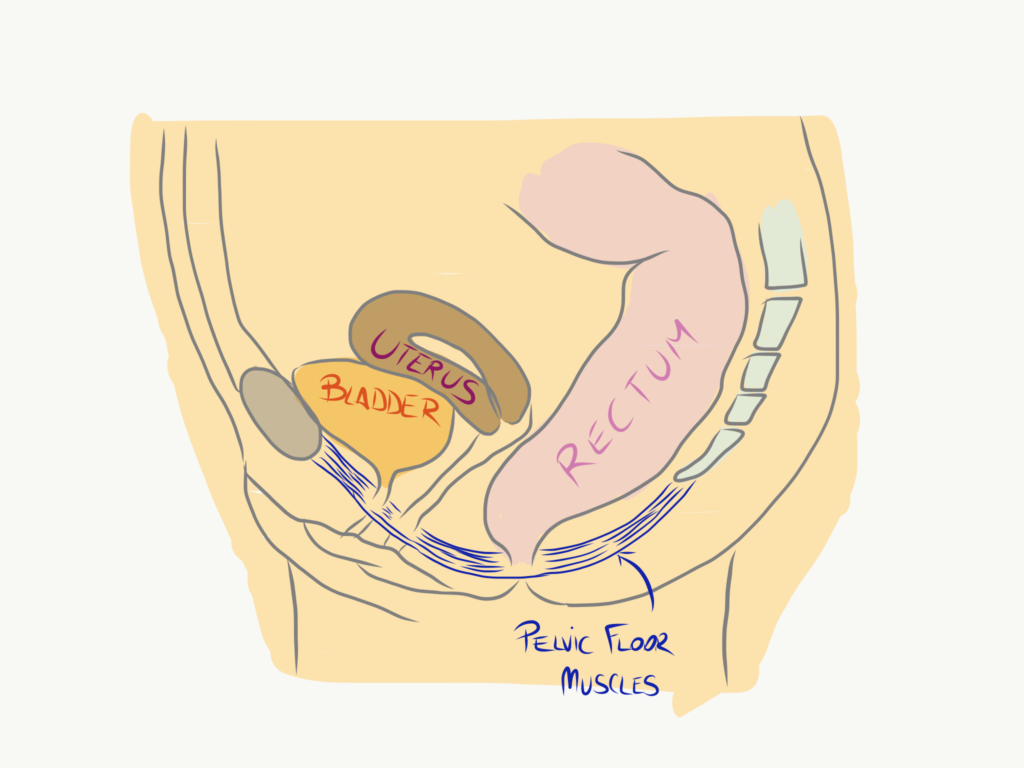
The way to do Kegel exercises during pregnancy is simple: you push in the same way you would do to stop peeing. However, it‘s best not to do them when you are actually peeing because it’s not great for your bladder.
Don’t move any other muscles (abdominals, legs…). You can do Kegel exercises anywhere and in any position because it’s just a contraction of those internal muscles. Keep the contraction for 5 seconds and then relax. Repeat for 10 reps.
You should do this five times a day (10 reps five times).
You can see this example of what a normal week would look like:
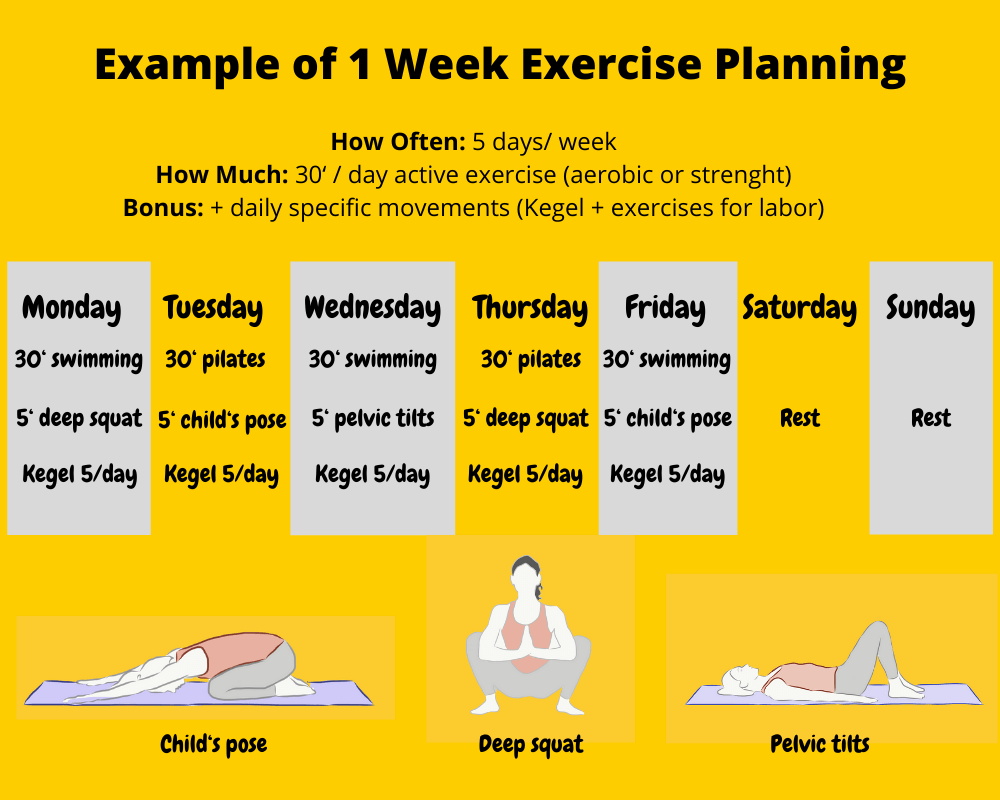
Leave a Reply